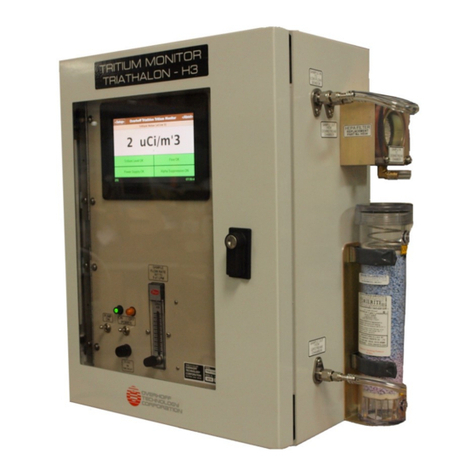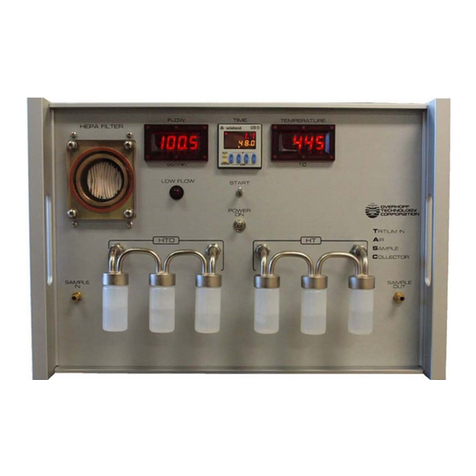
2
1.0. GENERAL INFORMATION
(see Figure 1, Front Panel)
1.1. INTRODUCTION
A tritium monitor is an instrument designed to determine the presence and level of radioactive gas
(tritium) in air or other gas streams. These monitors may be used to detect radioactive gases in
many applications like:
room air
stacks, hoods, or other effluent passages
process piping
glove boxes, and similar.
These monitors are generally calibrated in terms of (micro) Curies per cubic meter though other
units can be used as requested (Bequerel, pCi/cm3, etc.).
The principle of measurement is based on collecting the current that is generated by the radioactive
decay (of tritium) inside an ionization chamber. The ionization current is proportional to the
concentration of the gas radioactivity, as well as to the specific activity of the radionuclide (tritium)
being detected.
A tritium monitor consists of the following parts:
1. An ionization chamber to collect the ionization current.
2. A sampling system to circulate the sample (air) through the ionization chamber.
3. An electrometer to amplify the very weak ionization current.
4. All other associated electronics to process and display the signal.
Ionization chambers respond not only to the airborne radioisotope which circulates through the
ionization chamber, but also respond to the presence of external high energy radiation capable of
ionizing the air inside. Therefore, ionization chambers will respond to X-rays and gamma radiation
as well.
To overcome this effect, Overhoff Technology Corporation (OTC) tritium monitors can be supplied
with compensating ionization chambers. Here a second ionization chamber is used to cancel the
effects of external radiation upon the measuring ionization chamber. Additional gamma radiation
suppression can be accomplished by using lead shielding. OTC tritium monitors are equipped with
special circuitry to identify and reject ionization currents that are produced by decaying radon, or
other airborne alpha emitting radioisotopes.
1.2. AVAILABLE CONFIGURATIONS
OTC tritium monitors are available in a number of different configurations. Form and size depend
upon the application and use.
Portable instruments are battery powered and light weight.
Instruments used for fixed applications employ 19" rackmount enclosures which carry power
supplies and signal processing circuits. They may also contain the ionization chamber and
electrometer.
Ionization chambers and electrometers are available for remote installation where the "display"
enclosure is connected via a shielded ten conductor cable.





























